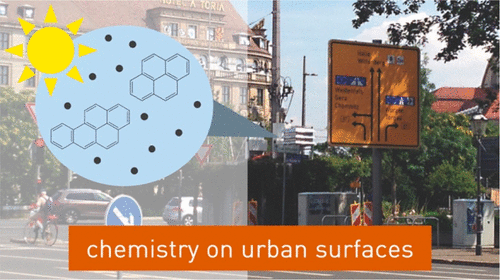当前位置:
X-MOL 学术
›
ACS Earth Space Chem.
›
论文详情
Our official English website, www.x-mol.net, welcomes your
feedback! (Note: you will need to create a separate account there.)
Organic Composition, Chemistry, and Photochemistry of Urban Film in Leipzig, Germany
ACS Earth and Space Chemistry ( IF 2.9 ) Pub Date : 2018-07-25 00:00:00 , DOI: 10.1021/acsearthspacechem.8b00087 Sarah A. Styler 1, 2 , Alyson M. Baergen 3 , D. J. Donaldson 3, 4 , Hartmut Herrmann 1
ACS Earth and Space Chemistry ( IF 2.9 ) Pub Date : 2018-07-25 00:00:00 , DOI: 10.1021/acsearthspacechem.8b00087 Sarah A. Styler 1, 2 , Alyson M. Baergen 3 , D. J. Donaldson 3, 4 , Hartmut Herrmann 1
Affiliation

|
In polluted urban environments, windows and building surfaces are coated with a complex film of chemicals. Despite its high surface-to-volume ratio and direct exposure to sunlight, few studies have directly investigated the role that this “urban film” may play in promoting the chemistry and photochemistry of semivolatile organic species contained within it. Here, we report results from a field investigation of the organic composition of urban film and particulate matter (PM10) samples collected at an urban site in Leipzig, Germany, in which we provide clear evidence for the influence of anthropogenic processes on film composition. In this study, we find that the ratio of water-soluble organic carbon (WSOC) to the total ionic content of film samples decreases with atmospheric exposure time, which suggests that urban film growth proceeds first via the condensation of semivolatile species, and that the coating thus formed enhances the dry deposition of particles. Further, we find that the polycyclic aromatic hydrocarbon (PAH) abundance profiles in light-exposed films are different from those in films collected under light-shielded conditions, which represents the first direct evidence that urban films serve as a photochemical sink for semivolatile organic pollutants. Finally, we find that the PAH and n-alkane profiles of urban film samples differ substantially from colocated PM10 samples, which we suggest reflects both the contribution of settled coarse particulate matter to the overall film composition and the influence of in-film oxidative processes. Together, these results highlight the unique reactive environment afforded by urban film and underscore the need for further studies of urban surface chemistry.
中文翻译:

德国莱比锡城市电影的有机组成,化学和光化学
在污染的城市环境中,窗户和建筑表面都覆盖着复杂的化学薄膜。尽管其高的表面体积比和直接暴露在阳光下,但很少有研究直接研究这种“城市膜”在促进其中所含半挥发性有机物的化学和光化学作用方面所起的作用。在这里,我们报告了对城市薄膜和颗粒物的有机组成进行现场调查的结果(PM 10)样品在德国莱比锡的一个城市地点采集,我们在其中为人为过程对胶片成分的影响提供了清晰的证据。在这项研究中,我们发现水溶性有机碳(WSOC)与薄膜样品中总离子含量之比随大气暴露时间而降低,这表明城市薄膜的生长首先通过半挥发性物质的冷凝而进行,并且如此形成的涂层增强了颗粒的干式沉积。此外,我们发现曝光膜中的多环芳烃(PAH)丰度曲线与在遮光条件下收集的膜中的多环芳烃丰度曲线不同,这是第一个直接证据表明城市膜可作为半挥发性有机污染物的光化学汇。最后,我们发现PAH和城市薄膜样品的正构烷烃曲线与共置的PM 10样品有很大不同,我们建议既反映沉降的粗颗粒物对整个薄膜组成的贡献,又反映薄膜内氧化过程的影响。总之,这些结果突出了城市胶卷所提供的独特反应环境,并强调了对城市表面化学进行进一步研究的必要性。
更新日期:2018-07-25
中文翻译:

德国莱比锡城市电影的有机组成,化学和光化学
在污染的城市环境中,窗户和建筑表面都覆盖着复杂的化学薄膜。尽管其高的表面体积比和直接暴露在阳光下,但很少有研究直接研究这种“城市膜”在促进其中所含半挥发性有机物的化学和光化学作用方面所起的作用。在这里,我们报告了对城市薄膜和颗粒物的有机组成进行现场调查的结果(PM 10)样品在德国莱比锡的一个城市地点采集,我们在其中为人为过程对胶片成分的影响提供了清晰的证据。在这项研究中,我们发现水溶性有机碳(WSOC)与薄膜样品中总离子含量之比随大气暴露时间而降低,这表明城市薄膜的生长首先通过半挥发性物质的冷凝而进行,并且如此形成的涂层增强了颗粒的干式沉积。此外,我们发现曝光膜中的多环芳烃(PAH)丰度曲线与在遮光条件下收集的膜中的多环芳烃丰度曲线不同,这是第一个直接证据表明城市膜可作为半挥发性有机污染物的光化学汇。最后,我们发现PAH和城市薄膜样品的正构烷烃曲线与共置的PM 10样品有很大不同,我们建议既反映沉降的粗颗粒物对整个薄膜组成的贡献,又反映薄膜内氧化过程的影响。总之,这些结果突出了城市胶卷所提供的独特反应环境,并强调了对城市表面化学进行进一步研究的必要性。











































 京公网安备 11010802027423号
京公网安备 11010802027423号